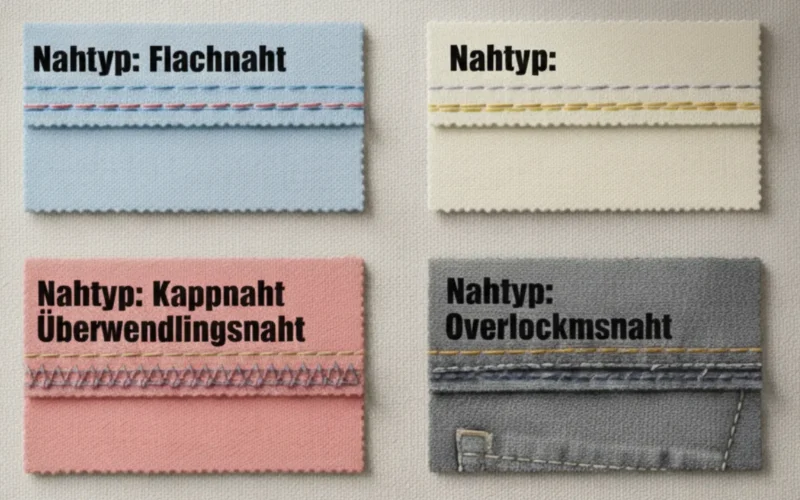When it comes to sewing, the right seam can make all the difference. Think of seams as the backbone of your fabric creations; they hold everything together and affect both durability and appearance. With a variety of nahttypen (seam types) available, each designed for different purposes and fabrics, choosing the perfect one can be daunting. Whether you’re crafting a delicate blouse or a sturdy pair of jeans, understanding each seam type will elevate your sewing game. Let’s dive into the world of seams and find out which ones best suit your projects!
Flat-Felled Seams: Strength and Durability
Flat-felled seams are renowned for their strength and durability. This seam type is a favorite in garments that endure wear and tear, such as jeans and workwear.
The construction involves folding the fabric edges inward before stitching them together. This process not only hides raw edges but also creates a robust bond between layers. The result? A seam that’s built to last.
Because of their sturdiness, flat-felled seams can withstand significant stress. They resist fraying, making them ideal for high-impact areas like underarms or crotches.
Additionally, these seams provide a polished look to any garment. Their neat finish adds an element of professionalism that elevates even simple designs.
Using flat-felled seams might require some additional sewing skills but the payoff is well worth it for long-lasting clothing pieces.
French Seams: A Clean and Professional Finish
French seams are a favorite among those who seek a polished look in their sewing projects. This technique encloses raw edges, preventing fraying and ensuring longevity.
To create a French seam, start by placing the fabric pieces with wrong sides together. After sewing a narrow seam, trim the excess fabric before folding the right sides together. A second pass through your machine will encase those raw edges securely.
This method is ideal for lightweight or delicate fabrics like silk or chiffon. It provides not only durability but also an elegant finish that adds sophistication to garments.
French seams can sometimes be more time-consuming than other methods. However, for special occasions or high-quality items, this extra effort pays off handsomely in appearance and feel.
Overlock or Serger Seams: Perfect for Knit Fabrics
Overlock seams, often created with a serger, are the go-to choice for knit fabrics. They’re designed to handle stretchy materials without compromising on integrity. This is crucial when working with items like t-shirts and leggings.
The beauty of overlock seams lies in their ability to stretch along with the fabric. Unlike traditional straight stitches that can break under tension, these seams keep everything intact during movement. This ensures comfort and longevity in your garments.
Another advantage is the clean finish they provide. Overlock machines trim away excess fabric while simultaneously stitching the edges, resulting in a polished look. You won’t have to worry about fraying edges or bulky seam allowances.
Whether you’re making casual wear or activewear, using an overlock seam elevates your project’s quality significantly. It’s an essential technique if you’re serious about sewing knits effectively.
Zigzag Seams: Flexible and Versatile
Zigzag seams are a go-to choice for many sewing enthusiasts. Their unique stitch creates a beautiful, wavy line that not only looks appealing but also serves practical purposes.
One of the standout features of zigzag seams is their flexibility. They stretch and move with knit fabrics, making them ideal for garments like t-shirts and leggings. This elasticity prevents fabric from tearing or fraying when worn.
In addition to strength, zigzag seams offer versatility in design. You can adjust the width and density of the stitches to suit different projects and preferences. Whether you’re working on delicate items or heavier materials, zigzag stitches adapt seamlessly.
Using this seam type can elevate your sewing game. It works well as both a finish on raw edges and as a decorative element on quilts or home decor projects. Zigzag seams truly deliver functionality wrapped in creative possibilities.
Considerations When Choosing a Seam Type
Choosing the right seam type involves several important factors. First, consider the fabric you’re working with. Heavier fabrics may require stronger seams like flat-felled or overlock, while lightweight materials often benefit from French seams.
Think about the intended use of your project. Garments that will experience a lot of stress should have durable seams to withstand wear and tear. For delicate items, opt for finishes that prevent fraying.
Another aspect is aesthetics. A clean finish enhances the overall appearance of your work, especially in visible areas.
Don’t forget functionality; some seams offer more stretch than others. For activewear or knit fabrics, zigzag or serger seams provide flexibility.
Tools and skills play a role too. Ensure you have access to appropriate sewing machines and are comfortable with specific techniques before deciding on a seam type.
Conclusion
When selecting a seam type, it’s essential to consider the fabric you’re working with and the intended use of your project. Each nahttyp has its strengths that can elevate your sewing game.
Flat-felled seams offer unmatched strength, making them ideal for heavy-duty fabrics like denim. French seams provide a refined look perfect for lightweight or sheer materials. Meanwhile, overlock seams are fantastic for knit fabrics due to their stretchability. Zigzag seams introduce flexibility into your projects, allowing for movement in various types of garments.
Think about how often you’ll wear or wash the finished item too. Durability may be crucial if it’s something you plan on using frequently. On the other hand, aesthetics should weigh heavily when creating dressy attire.
Choosing the right seam type can transform not just how your garment looks but also its longevity and comfort level. So take some time to match each nahttyp with your specific fabric needs and enjoy crafting pieces that stand out!




